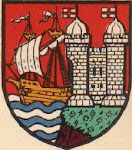(xxx-1683) Report from Colonel
Sturm to the
Stadtrat.
We awoke early to news from our pickets that the Ottomans had crossed the river
Slava. This was dire news as so far the area of Austria in which we were moving had been spared from the depredations of the Turks. Our forces rapidly mustered, our one chance was to defeat the enemy before their whole force had crossed the river.
We approached to find a substantial body of the foe across the river, but still not in sufficient number so General
Kratz ordered an immediate attack. On our left were two regiments of Austrian
cuirassiers ten our brigade of foot our regiment and two Austrian regiments. In the centre was out main thrust of three regiments of cavalry drawn up in succession of lines on the right was another Austrian infantry brigade.
The Ottomans had almost reached a hill in their centre and covered the gap between it and a marsh with a regiment of
Janissaries and another of
Azabs. behind them were Light horse and
Sipahis. On their left were just a another unit of light horse back up by more
sipahis In addition more light cavalry could be seen crossing the bridge. Out artillery was positioned on the nearby hills to provide supporting fire but the Ottomans had positioned their guns to provide flanking fire from the opposite river bank.
Our force steadily advanced and the first clash occur ed between the leading Austrian dragoons and the enemy light cavalry, as expected these were routed easily, but the enemy
sipahis then charged the dragoons routing them in turn, pursuing them into the gap between our centre and the right flank infantry.
This was the crisis, but the enemy had sent their right flank cavalry round the marsh to extend
their line and the newly arrived light cavalry had done the same on the right. However a regiment of delis had crossed the river and was heading for the central hill.
Colonel
Lowenstein then grasped the opportunity and leaving the
sipahis to be deal with by the following dragoons led his men over the central hill and into the midst of the enemy.
The dragoons and infantry dealt with the
sipahis before they could reach our gun line. meanwhile breasting the hill before the enemy Colonel
Lowenstein saw a great target ahead the Delis were still advancing in column and the
Janissaries had their flank exposed as they faced the approach of or infantry. "
Vorwarts" cried Colonel
Lowenstein and his men surged forward in a determined mass, causing the
Jannisaries to rout, but the fanatical Delis were a bigger problem and the charge became a maelstrom of hard fought actions.
After much maneuvering the Ottoman right flank cavalry had reformed after skirting the marsh and now charged against the Austrian
cuirassiers. They were well positioned and both regiments counter-charged the
sipahis, who were unsupported by their light horse. Although one regiment was checked weight of numbers told and the
sipahis routed. The pursuing regiment then drove straight though the enemy light horse routing them in turn.
At the same moment our
cuirassiers were triumphant and routed the Delis driving them into the river.
From this point on the Ottomans on our bank of the river routed back across the bridge or attempted to swim the
Slava and a great many drowned. The light horse, who were mainly
Transylvanians surrendered.
-----------------------------------------This was played with the latest draft of the rules, they worked better but I still found areas to improve. Once I make the next set of updates I'll put them up on esnips.Thanks to Paul and Daffyd for participating




